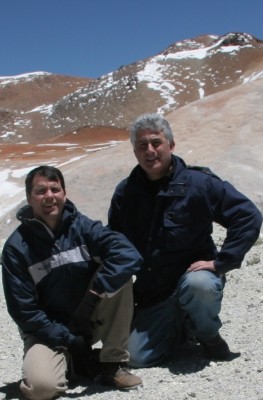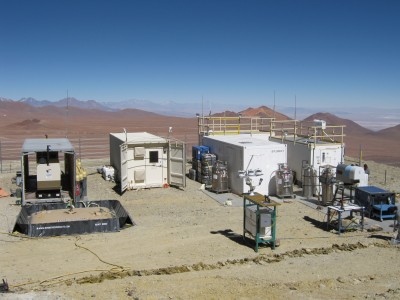The Air is Rare Up There!
Published: 17 August 2009
Science team ascends nearly to height of Everest’s base camp for atmospheric data

This week, on a mountain rising from the Chajnantor Plateau in Chile’s Atacama Desert, researchers began a two-month effort to obtain rare and valuable measurements from the far reaches of Earth’s atmosphere. Using several sophisticated optical instruments called spectrometers, phase two of the Radiative Heating in Underexplored Bands Campaign will obtain a detailed data set of measurements in the infrared portion of the electromagnetic spectrum. These data will ultimately improve the mathematical formulas used to calculate energy transfer in climate models.
Sponsored by the ARM Climate Research Facility, scientists from the University of Wisconsin-Madison and Atmospheric Environmental Research, Inc. are being joined by researchers from the University of Denver, the Smithsonian Astrophysical Observatory, NASA’s Langley Research Center, and the Istituto di Fisica Applicata in Italy. Each organization is providing a different type of spectrometer that will allow the team to obtain simultaneous measurements from specific portions of the infrared spectrum – a first, according the study’s lead scientist.
“Only three groups in the world make spectrally resolved radiance observations in the far-infrared [wavelengths longer than 15 microns] and two of those groups are in this campaign; the other participated in the first phase of the study in Alaska in 2007,” said Dave Turner, a scientist from the University of Wisconsin-Madison and one of the principal investigators for the study.
“But, perhaps more importantly, this is the first experiment that I know of that is making spectrally resolved measurements of downwelling radiation from 1 to 1000 microns in wavelength simultaneously,” he added.
High-altitude challenges? No un problema!

With the remote campaign site located at an altitude of 5383 meters on Cerro Toco (Mt. Everest’s base camp is only slightly higher at 5456 meters), the team will trek daily from San Pedro de Atacama, a nearby village, to operate their instruments. In addition to the spectrometers, a dozen more ground-based instruments will operate continuously throughout the campaign. These instruments, also provided by the ARM Climate Research Facility, will provide atmospheric state measurements such as temperature, pressure, humidity, and incoming and outgoing energy.
All the instrumentation was shipped to San Pedro in July. From there it was trucked to the Chajnantor Plateau and up to its final destination on Cerro Toco. Between a few surprise snow storms, the RHUBC-II team installed the Self-Kontained Instrument Platform, or SKIP, and configured the entire instrument layout.
To prepare for daily operations in the low-oxygen concentrations on Cerro Toco, the onsite RHUBC-II team completed required physicals and training. As an added precaution, two of the enclosures contain a device that enhances the concentration of oxygen to provide relief for team members as needed.
After testing the operational readiness of all the instruments and data systems, including a weather balloon launch, official data collection began on August 16 and will continue through the end of October.
The ARM Climate Research Facility is a DOE Office of Science user facility. The ARM Facility is operated by nine DOE national laboratories, including .
Keep up with the Atmospheric Observer
Updates on ARM news, events, and opportunities delivered to your inbox
ARM User Profile
ARM welcomes users from all institutions and nations. A free ARM user account is needed to access ARM data.


















